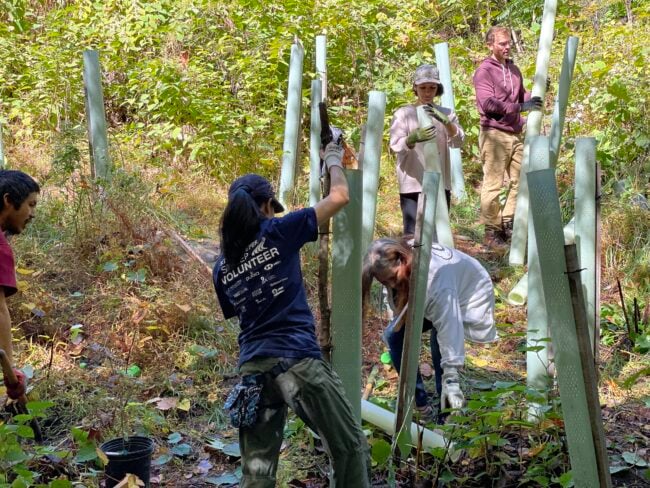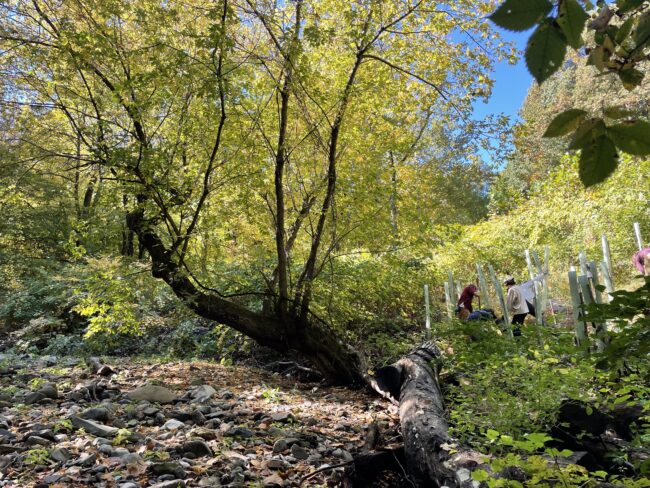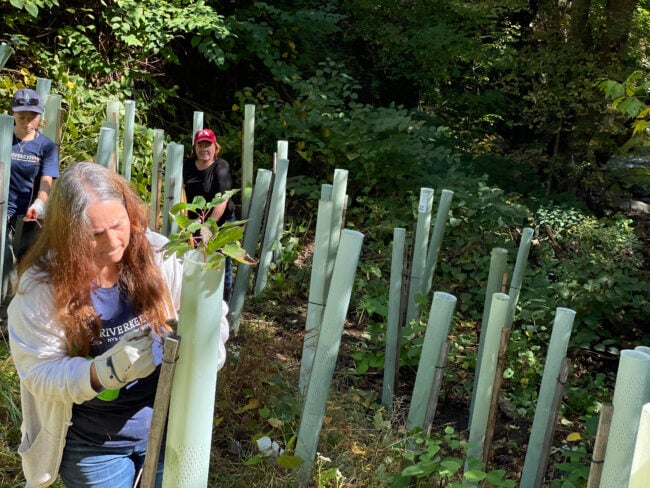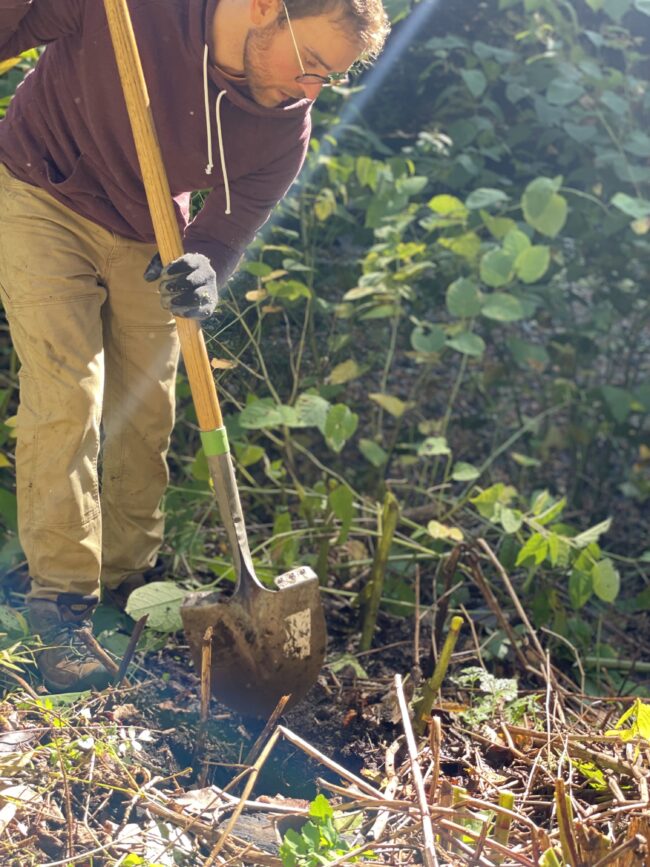Planting trees, finding new life at the site of a dam removal on Quassaick Creek
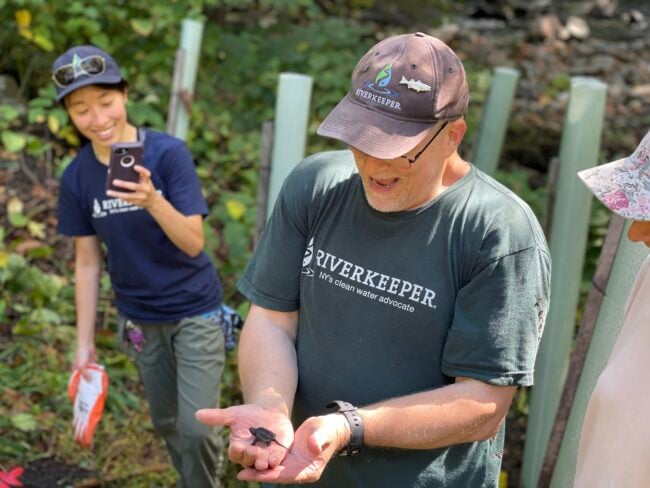
View more images on our Flickr site
Two years after taking down the Strooks Felt Dam in Newburgh, Riverkeeper, DEC and Quassaick Creek Alliance collaborate on a tree-planting to help rewild the creek.

This month Riverkeeper returned to the banks of the Quassaick Creek in Newburgh, just upstream from where it meets the Hudson, and just up the slope from where a concrete dam used to block the flow of water. Riverkeeper staff and volunteers, partnering with the Quassaick Creek Watershed Alliance, planted 100 native trees and cleared invasive plants alongside the rushing water in a continuing effort to restore a healthy, free flowing stream.
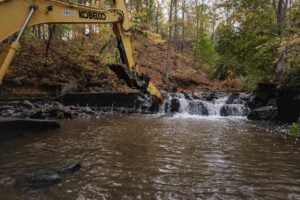
THEN: October 2020 (Photo by Jess Deitz)
It’s been two years since Riverkeeper teamed up with the New York State Department of Environmental Conservation, Orange County, and the City of Newburgh to remove the 136-year-old Strooks Felt Dam at that location.
The Strooks Felt dam formed the first barrier up from the Hudson on the Quassaick Creek and followed earlier barriers dating back three centuries.
By removing dams like these, we’re taking steps to restore critical habitat for imperiled migratory fishes that rely on these streams to renew their populations.
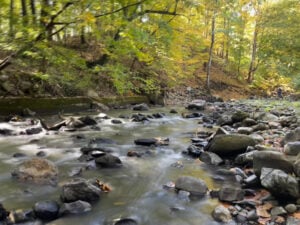
NOW: October 2022
The restoration plan was approved by the City of Newburgh and supported by the DEC Trees for Tribs program. DEC supplied 100 yearling native tree species, along with stakes and tubes for planting them. The tubes are necessary to protect the young trees while they are still vulnerable to the effects of browsing deer. It was the second tree planting aimed at rewilding the stream. In 2021, we collaborated on a similar project, and planted 60 young trees donated by Trout Unlimited.
The trees help prevent erosion and stabilize the stream banks as the creek re-establishes itself after a dam removal. The trees were densely planted, in hopes that they will shade out the invasive plants that threaten to return in the future.
During the tree planting, we found a newly hatched snapping turtle ambling up the bank. This precocious young turtle was hardly intimidated by our presence. Upon close examination, the turtle showed us the cutest face, reminding us of a baby dinosaur cartoon. This is not surprising, since snapping turtles are phylogenetically related to dinosaurs. Later, once everyone was gone and I was pondering our planting for the day, I had a surprise encounter with a doe and a fawn crossing the creek.
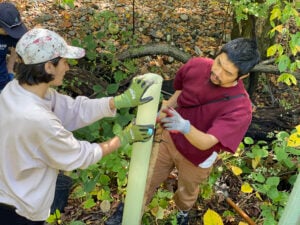 The presence of the young turtle and the deer affirm that restoring creeks benefits more than the fish. Removing obsolete dams and planting trees can better support biodiversity in these vital riparian corridors. The sight of these creatures reassures us that our efforts in restoring the Hudson’s tributaries is beneficial for entire ecosystems. See the links below about one of our next projects, and read about similar restoration work on Furnace Brook in Westchester County.
The presence of the young turtle and the deer affirm that restoring creeks benefits more than the fish. Removing obsolete dams and planting trees can better support biodiversity in these vital riparian corridors. The sight of these creatures reassures us that our efforts in restoring the Hudson’s tributaries is beneficial for entire ecosystems. See the links below about one of our next projects, and read about similar restoration work on Furnace Brook in Westchester County.
The site will require further maintenance next spring, and again in the summer, to trim back the invasive plants as they attempt to crowd our young tree stock. Riverkeeper will be back with partners supplying the energy and effort to maintain the Quasaaick Creek and the riparian corridor. No dam is removed without a plan, and a restored creek is never forsaken nor forgotten. Riverkeeper remains faithful to its mission.
Learn more
Listen to Media Sanctuary’s Hudson Mohawk Magazine: Riverkeeper Promotes Dam Removal to Restore Fish Migration
Read the Times Union: Goodbye Rensselaer dam, hello herring
Visit Riverkeeper.org/dams
You can help restore habitat and heal the Hudson’s tributaries by becoming a Riverkeeper member or renewing your Riverkeeper membership with a gift of any amount.
